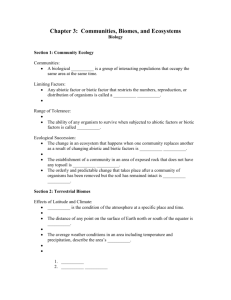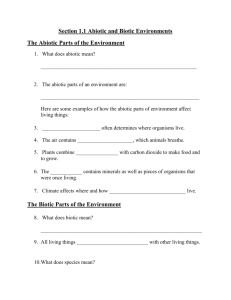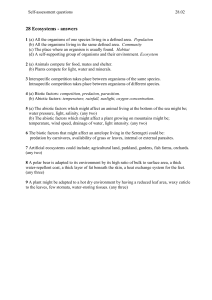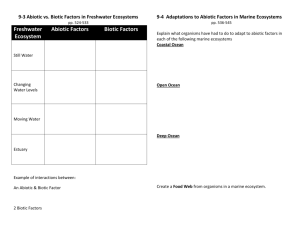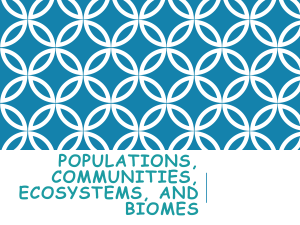Cycles of Matter and the Flow of Energy Part 2
advertisement
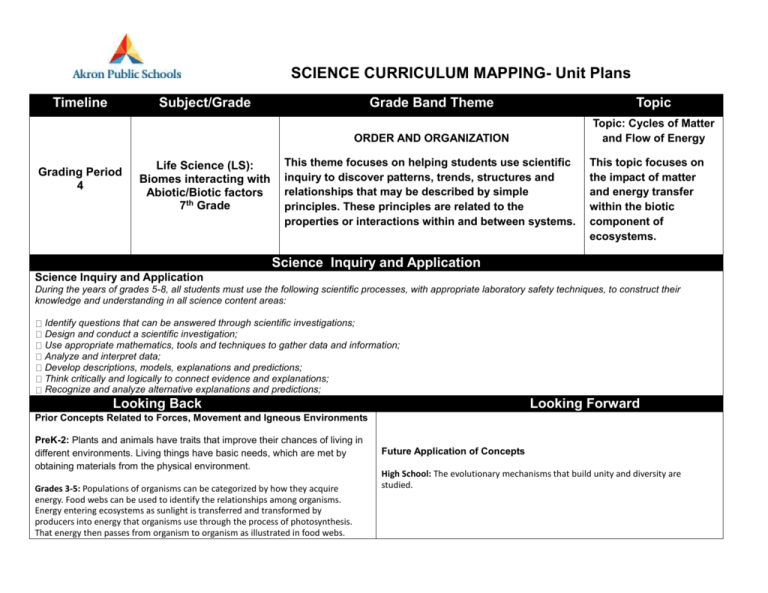
SCIENCE CURRICULUM MAPPING- Unit Plans Timeline Subject/Grade Grading Period 4 Life Science (LS): Biomes interacting with Abiotic/Biotic factors 7th Grade Grade Band Theme Topic ORDER AND ORGANIZATION Topic: Cycles of Matter and Flow of Energy This theme focuses on helping students use scientific inquiry to discover patterns, trends, structures and relationships that may be described by simple principles. These principles are related to the properties or interactions within and between systems. This topic focuses on the impact of matter and energy transfer within the biotic component of ecosystems. Science Inquiry and Application Science Inquiry and Application During the years of grades 5-8, all students must use the following scientific processes, with appropriate laboratory safety techniques, to construct their knowledge and understanding in all science content areas: Identify questions that can be answered through scientific investigations; Design and conduct a scientific investigation; Use appropriate mathematics, tools and techniques to gather data and information; Analyze and interpret data; Develop descriptions, models, explanations and predictions; Think critically and logically to connect evidence and explanations; Recognize and analyze alternative explanations and predictions; Looking Back Looking Forward Prior Concepts Related to Forces, Movement and Igneous Environments PreK-2: Plants and animals have traits that improve their chances of living in different environments. Living things have basic needs, which are met by obtaining materials from the physical environment. Grades 3-5: Populations of organisms can be categorized by how they acquire energy. Food webs can be used to identify the relationships among organisms. Energy entering ecosystems as sunlight is transferred and transformed by producers into energy that organisms use through the process of photosynthesis. That energy then passes from organism to organism as illustrated in food webs. Future Application of Concepts High School: The evolutionary mechanisms that build unity and diversity are studied. Strand Connections/Topic Details (STANDARD) OVERALL Strand Connections: Systems can exchange energy and/or matter when interactions occur within systems and between systems. Systems cycle matter and energy in observable and predictable patterns. Topic: Cycles of Matter and Flow of Energy This topic focuses on the impact of matter and energy transfer within the biotic component of ecosystems Condensed Content Statements (LEARNING GOALS) Content Standards: G7.LS. 2. Cycles of Matter and Flow of Energy ~ In any particular biome, the number, growth and survival of organisms and populations depend on biotic and abiotic factors. Content Elaboration (LEARNING TARGETS) Biomes are regional ecosystems characterized by distinct types of organisms that have developed under specific soil and climatic conditions. The variety of physical (abiotic) conditions that exists on Earth gives rise to diverse environments (biomes) and allows for the existence of a wide variety of organisms (biodiversity). Ecosystems are dynamic in nature; the number and types of species fluctuate over time. Disruptions, deliberate or inadvertent, to the physical (abiotic) or biological (biotic) components of an ecosystem impact the composition of an ecosystem. Note: Predator-prey and producer-consumer relations are addressed in grade 5. Grade 7 Concepts Biomes are defined by abiotic components of the environment – topography, soil types, precipitation, solar radiation and temperature. Comparing the different biomes found on Earth is the focus of this content statement. Examples of the Earth’s biomes include aquatic (freshwater, brackish water and marine water), forest (tropical and temperate), desert (cold and hot), grassland, taiga and tundra. Biomes must be linked to climate zones on a global level by using a variety of maps, models and technology (e.g., remote sensing, satellite images, LANDSAT). This content statement is connected to the ESS middle school content pertaining to global climate patterns. An ecosystem is composed of linked and fluctuating interactions between biotic and abiotic factors. Given adequate resources and an absence of disease or predators, populations of organisms in ecosystems increase at rapid rates. Finite resources and other factors limit population growth. As one population proliferates, it is held in check by one or more environmental factors (e.g., depletion of food or nesting sites, increased loss to predators, invasion by parasites). If a natural disaster such as a flood or fire occurs, the damaged ecosystem is likely Misconceptions Students often think that: Common Misconceptions bout interactions between organisms in an ecosystem. Materials Resources Anticipatory Set Procedures Reflection Lesson reflection: Reflective statement of lesson detailing strengths and opportunities for improvement Next Steps:

